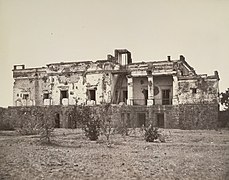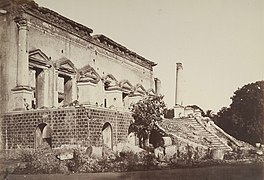
Indian Rebellion of 1857
The Indian Rebellion of 1857 was a major uprising in India in 1857–58 against the rule of the British East India Company, which functioned as a sovereign power on behalf of the British Crown.[4][5] The rebellion began on 10 May 1857 in the form of a mutiny of sepoys of the company's army in the garrison town of Meerut, 40 mi (64 km) northeast of Delhi. It then erupted into other mutinies and civilian rebellions chiefly in the upper Gangetic plain and central India,[b][6][c][7] though incidents of revolt also occurred farther north and east.[d][8] The rebellion posed a military threat to British power in that region,[e][9] and was contained only with the rebels' defeat in Gwalior on 20 June 1858.[10] On 1 November 1858, the British granted amnesty to all rebels not involved in murder, though they did not declare the hostilities to have formally ended until 8 July 1859.
"Sepoy Mutiny" redirects here. For other uses, see Sepoy Mutiny (disambiguation).
The name of the revolt is contested, and it is variously described as the Sepoy Mutiny, the Indian Mutiny, the Great Rebellion, the Revolt of 1857, the Indian Insurrection, and the First War of Independence.[f][11]
The Indian rebellion was fed by resentments born of diverse perceptions, including invasive British-style social reforms, harsh land taxes, summary treatment of some rich landowners and princes,[12][13] as well as scepticism about the improvements brought about by British rule.[g][14] Many Indians rose against the British; however, many also fought for the British, and the majority remained seemingly compliant to British rule.[h][14] Violence, which sometimes betrayed exceptional cruelty, was inflicted on both sides, on British officers, and civilians, including women and children, by the rebels, and on the rebels, and their supporters, including sometimes entire villages, by British reprisals; the cities of Delhi and Lucknow were laid waste in the fighting and the British retaliation.[i][14]
After the outbreak of the mutiny in Meerut, the rebels quickly reached Delhi, whose 81-year-old Mughal ruler, Bahadur Shah Zafar, was declared the Emperor of Hindustan. Soon, the rebels had captured large tracts of the North-Western Provinces and Awadh (Oudh). The East India Company's response came rapidly as well. With help from reinforcements, Kanpur was retaken by mid-July 1857, and Delhi by the end of September.[10] However, it then took the remainder of 1857 and the better part of 1858 for the rebellion to be suppressed in Jhansi, Lucknow, and especially the Awadh countryside.[10] Other regions of Company-controlled India—Bengal province, the Bombay Presidency, and the Madras Presidency—remained largely calm.[j][7][10] In the Punjab, the Sikh princes crucially helped the British by providing both soldiers and support.[k][7][10] The large princely states, Hyderabad, Mysore, Travancore, and Kashmir, as well as the smaller ones of Rajputana, did not join the rebellion, serving the British, in the Governor-General Lord Canning's words, as "breakwaters in a storm".[15]
In some regions, most notably in Awadh, the rebellion took on the attributes of a patriotic revolt against British oppression.[16] However, the rebel leaders proclaimed no articles of faith that presaged a new political system.[l][17] Even so, the rebellion proved to be an important watershed in Indian and British Empire history.[m][11][18] It led to the dissolution of the East India Company, and forced the British to reorganize the army, the financial system, and the administration in India, through passage of the Government of India Act 1858.[19] India was thereafter administered directly by the British government in the new British Raj.[15] On 1 November 1858, Queen Victoria issued a proclamation to Indians, which while lacking the authority of a constitutional provision,[n][20] promised rights similar to those of other British subjects.[o][p][21] In the following decades, when admission to these rights was not always forthcoming, Indians were to pointedly refer to the Queen's proclamation in growing avowals of a new nationalism.[q][r][23]
Michael Adas (1971) examines the historiography with emphasis on the four major approaches: the Indian nationalist view; the Marxist analysis; the view of the Rebellion as a traditionalist rebellion; and intensive studies of local uprisings.[197] Many of the key primary and secondary sources appear in Biswamoy Pati, ed. 1857 Rebellion.[198][199]
Thomas R. Metcalf has stressed the importance of the work by Cambridge professor Eric Stokes (1924–1981), especially Stokes' The Peasant and the Raj: Studies in Agrarian Society and Peasant Rebellion in Colonial India (1978). Metcalf says Stokes undermines the assumption that 1857 was a response to general causes emanating from entire classes of people. Instead, Stokes argues that 1) those Indians who suffered the greatest relative deprivation rebelled and that 2) the decisive factor in precipitating a revolt was the presence of prosperous magnates who supported British rule. Stokes also explores issues of economic development, the nature of privileged landholding, the role of moneylenders, the usefulness of classical rent theory, and, especially, the notion of the "rich peasant".[200]
To Kim A. Wagner, who has conducted the most recent survey of the literature, modern Indian historiography is yet to move beyond responding to the "prejudice" of colonial accounts. Wagner sees no reason why atrocities committed by Indians should be understated or inflated merely because these things "offend our post-colonial sensibilities".[201]
Wagner also stresses the importance of William Dalrymple's The Last Mughal: The Fall of a Dynasty, Delhi 1857. Dalrymple was assisted by Mahmood Farooqui, who translated key Urdu and Shikastah sources and published a selection in Besieged: Voices from Delhi 1857.[202] Dalrymple emphasized the role of religion and explored in detail the internal divisions and politico-religious discord amongst the rebels. He did not discover much in the way of proto-nationalism or any of the roots of modern India in the rebellion.[203][204] Sabbaq Ahmed has looked at the ways in which ideologies of royalism, militarism, and Jihad influenced the behaviour of contending Muslim factions.[205]
Almost from the moment the first sepoys mutinied in Meerut, the nature and the scope of the Indian Rebellion of 1857 has been contested and argued over. Speaking in the House of Commons in July 1857, Benjamin Disraeli labelled it a 'national revolt' while Lord Palmerston, the Prime Minister, tried to downplay the scope and the significance of the event as a 'mere military mutiny'.[206] Reflecting this debate, an early historian of the rebellion, Charles Ball, used the word mutiny in his title, but labelled it a "struggle for liberty and independence as a people" in the text.[207] Historians remain divided on whether the rebellion can properly be considered a war of Indian independence or not,[208] although it is popularly considered to be one in India. Arguments against include:
A second school of thought while acknowledging the validity of the above-mentioned arguments opines that this rebellion may indeed be called a war of India's independence. The reasons advanced are:







